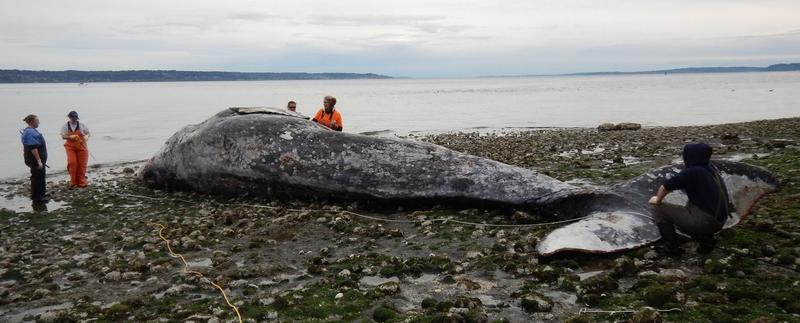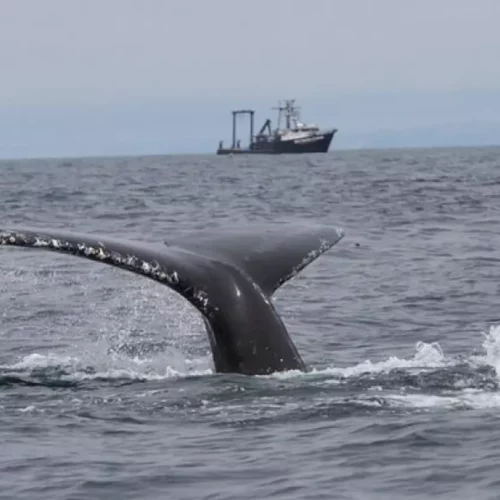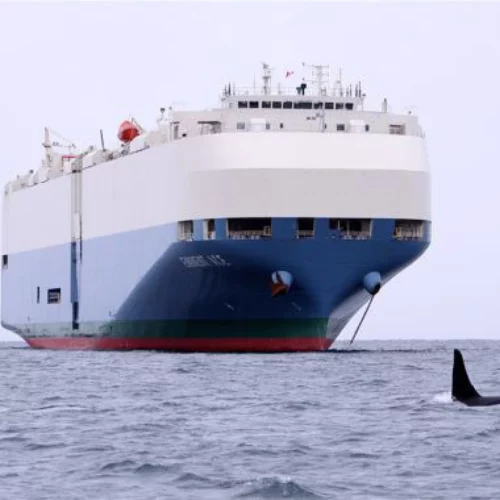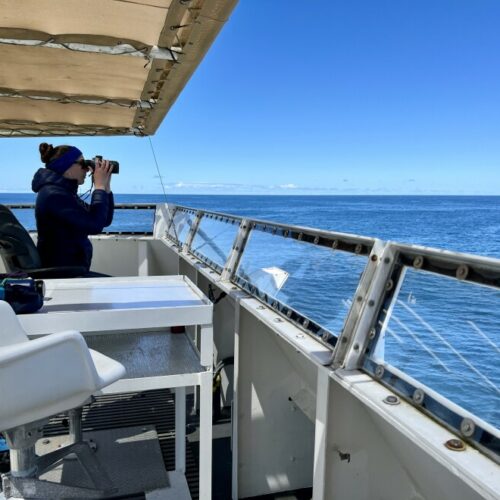
Why Are So Many Gray Whales Washing Up Dead On Pacific Northwest Beaches?
TOP PHOTO: Responders examine a malnourished adult gray whale on April 15, 2019 after it was towed to a remote beach after initially being found floating near downtown Seattle. CREDIT: CASCADIA RESEARCH COLLECTIVE
LISTEN
An unusually large number of gray whales are washing up dead on their northbound migration past the Oregon and Washington coasts this year.
The peak stranding time for gray whales in the Pacific Northwest is normally April, May and June. But the federal agency NOAA Fisheries has already logged nine dead whales washed ashore in Washington and one in Oregon. That’s on top of 21 strandings on California beaches since the beginning of the year.
There were a total of 25 dead gray whale strandings West Coast-wide in all of 2018.
One 39-foot long dead adult whale was found floating in Elliott Bay last week, right in front of downtown Seattle.
“This is looking like it is going to be a big year for gray whale strandings,” said Jessie Huggins, stranding coordinator for the Olympia-based Cascadia Research Collective.
Since February, Huggins has participated in necropsies of malnourished, mostly adult, gray whales on Whidbey Island and the Key Peninsula to Ocean Shores and Long Beach, Washington.
“We’re seeing very thin whales with little to no food in their stomachs,” Huggins said in an interview Wednesday. “This is kind of leading us to believe that this is an issue of nutritional stress with a few normal-type strandings mixed in.”
Huggins said these whales probably didn’t get fat enough on their summer feeding grounds in Alaskan waters way back last year.
Responders in raingear and elbow-high rubber gloves cut into the massive carcasses to examine the animals’ fat reserves and internal organs. Multiple whales exhibited dry fibrous blubber. The responders noted ribcages and vertebra sticking out, measured healed scars and took tissue samples for later analysis for contaminants.
Despite the unusual number of dead whales found, NOAA Fisheries spokesman Michael Milstein said the overall population of gray whales is fine, “probably as big as it’s ever been” in modern times.
Eastern Pacific gray whales were taken off the endangered species list in 1994. The population is now estimated at 27,000, which may be around the carrying capacity of their ocean territory.
“They’ve been coming back strong,” said Milstein by telephone from Portland Wednesday.
Gray whale and humpback whale casualties from entanglement in commercial and tribal fishing gear have been a growing concern for federal officials, certain environmental groups and the fishing industry lately. None of dead gray whales found this spring on Oregon and Washington beaches were entangled in fishing or crabbing lines, however.
Crabbers and fishing boat owners are scheduled to meet with researchers and government representatives when two separate work groups convene next month along the Oregon and Washington coasts to hear updates about entanglement risk reduction strategies.
Sometimes it takes a village to examine and pull samples from a decomposing whale. Huggins said she has worked alongside colleagues this winter and spring from Portland State University, Seattle Pacific University, the nonprofit SR3, Washington Department of Fish & Wildlife and World Vets.
If you see a stranded whale (or other marine mammal in distress), you can report it to the West Coast Marine Mammal Stranding Hotline: 1-866-767-6114.
Related Stories:

Lots of whales spotted around offshore wind farm zones along West Coast
The federal government has commissioned Oregon State University to look into the possible impacts of offshore wind farms on marine wildlife. In the first year of this four-year project, the researchers spotted sizable numbers of seabirds and whales — including the largest animal on Earth — in the Oregon and Northern California areas that could one day host floating wind farms.

Reducing collisions between ships and whales? There’s apps for that, but they need work
Fortunately, it doesn’t happen very often in the Pacific Northwest that ships collide with whales. But when it does, it’s upsetting, tragic and the whale probably dies. Three separate teams have developed smartphone-based systems that can alert commercial mariners to watch out, slow down or change course when whales have been sighted nearby. A recent ride-along on a big container ship demonstrated that real-time whale alerts are still a work in progress.

Watching For Whales – And Their Food
Scientists aboard the Bell M. Shimada keep an eye out for whales. One scientist hopes to help predict where whales will show up by studying the food they eat.















